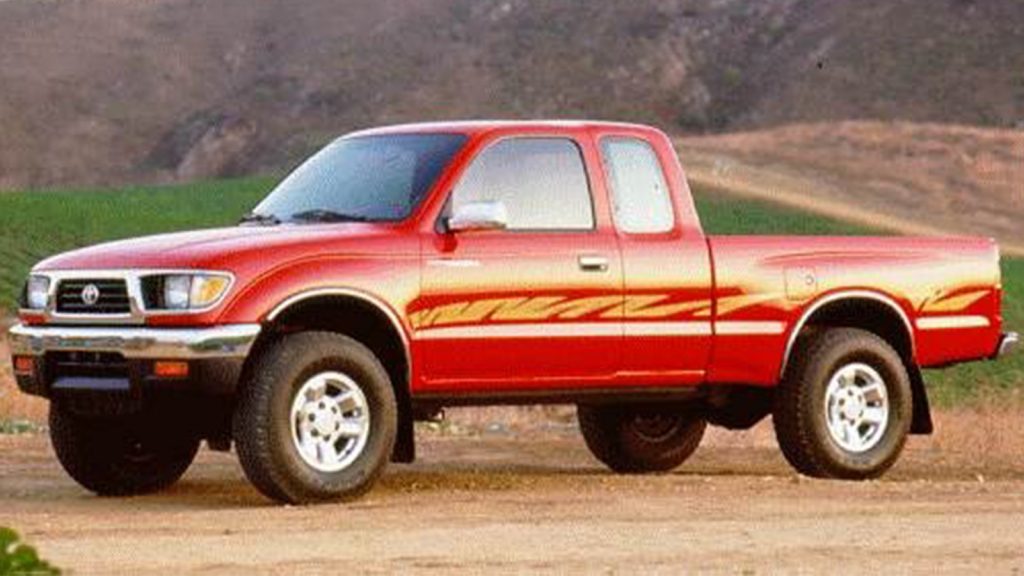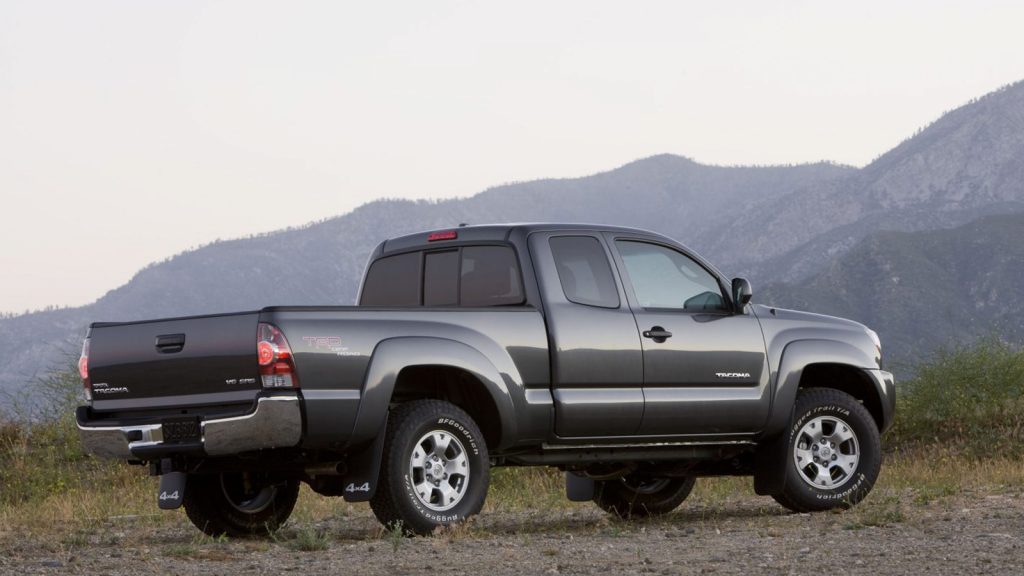This Friday the world is going to get a look at the latest model of its favorite Mexico-built Japanese truck with the launch of the 4th-generation 2024 Toyota Tacoma. Why do we all care so much?
[Ed note: I asked former Tacoma owner, truck guy™ and occasional contributor Joel Johnson to write about the Tacoma launch to explain why everyone is going crazy for this new truck. We’ve also got Mercedes in Hawaii and she’ll have even more info about the new Tacoma tomorrow – MH]
The Tacoma is almost 30. The first truck, a 1995 model, sold respectfully well from its launch (around 90k units in the first year) and ticked up steadily every year through its second iteration and into the third. Now, nearly a quarter-million Tacomas are sold in the U.S. and Canada each year.

To save ourselves from a lengthy preamble, here is the received wisdom about the Toyota Tacoma’s success:
- Tacomas run forever compared to most other trucks. They’re reliable and hold their value.
- Americans came to appreciate small trucks more as American manufacturers focused on full-sized trucks.
- Marty McFly had one. (Or at least the Tacoma’s precursor, the Toyota, uh, Truck.)
- That ‘Top Gear’ episode where they dropped a Hilux (the Tacoma’s well-traveled global cousin) was many people’s first recognition of both the stoutness of Toyota Trucks—and, for many, their first exposure to “Top Gear.”
- They are the machine gun platform of choice for global terrorists and militias.
And sure, those were all factors. Big ones (except for the last one, which maybe is a bad thing). The kind of brand equity you can’t fake, because it comes from the product’s qualities. (Except for the “Back To The Future” placement, maybe.)
There’s another way to diagram this story, though, and it’s just about price and value.
- The first gens were small, reliable, and cheap.
- The second gens were reliable and affordable.
- The third gens were reliable and affordable compared to the full-size truck competition.
[Editor’s Note: And available. Remember, there was a time around 2013 when you couldn’t buy a mid-size truck from GM, Ford, or Dodge/Ram. And certainly not Jeep. The Toyota has been a mainstay, and it’s been able to build up a brand gradually rather than resetting with a product so different than its predecessor. -DT].
By the time the second-gen Tacoma was about to be superseded, the reputation was close to cemented: first truck? Tacoma. Downsizing from a full-size? Tacoma. Want to dabble in off-roading and overlanding? Tacoma. Cheap bastard who just wants a truck and doesn’t want to buy another one for 15 years? Tacoma.

So Tacoma prices started doing something akin to what market forces do to other icons. The new ones got more expensive—largely as Toyota added premium trim levels—and the old ones also went up in price. This in part because most of them were beat on and had rust issues, including a major frame recall in both the first and second generations, and were still driven two-hundred- or three-hundred-thousand miles, so there was some scarcity to factor in. Even accounting for the post-pandemic car pricing chaos, Tacos are carrying major price premiums today. A clean first-generation Tacoma with less than 100,000 miles costs half of what a new mid-tier Tacoma does today.
But here’s the thing: to me, the thing that makes a Tacoma great is that it’s simply fine. It’s okay! It’s an okay truck that does all truck things okay-ly. It’s your friend who isn’t much of a conversationalist and buys his clothes at Costco and doesn’t like mustard on his sandwiches because it doesn’t have any sugar in it. That friend is dear and valued. Because he’s reliable. He helps you move a couch. He pays his share of the bill. He listens to your stupid jokes and laughs. He knows who he is and is satisfied to meet his own standards—all too rare.

The Tacoma is “The Tacoma” not because it gets B-minuses across the board, but because it doesn’t ever get any C’s. Its frame isn’t the strongest. Its engine is boring and doesn’t make a lot of power. It looks nice enough, but needs another truck’s worth of parts to look neoclassically “badass.” It can go off-road to anywhere a normal person would need to go off-road, but isn’t hard to park.
I have every reason to believe that the fourth-generation Tacoma, which we’re going to see in on Friday, is going to be fine to fine-plus. Toyota is incredible at fine-plus. And there’s no reason to think it won’t be reliable. If we can trust any company to keep that promise, it’s Toyota, although they’re still just a big corporation and they have engineering and quality issues just like everyone else.
But what it probably won’t be anymore is affordable. The price will go. Maybe a lot. Two reasons:
- The brand’s reputation is approaching Porsche 911 levels of quintessence, where many shoppers aren’t comparing it to competitors—for better or worse—but instead cross-shopping trim levels within the line.
- Shit’s more expensive now.
I can’t fault dealers for marking up hot cars. I can loathe them and wish that their entire business model never existed in the first place, but a buck’s a buck. And I can’t fault Toyota for charging as much as they can for a product that is inarguably very good.

But there’s a space that the Tacoma used to fill—small, reliable, cheap…and readily available for purchase—that I suspect the Tacoma won’t fill anymore. Unibody trucks like the Ford Maverick could take its place, if enough ever get built. But they’re not body-on-frame, dirt-simple machines that are cheap to run and (usually) simple to repair.
It may be that the Tacoma can’t be the Tacoma anymore because new cars can’t be just machines anymore, and while the implications of cars getting more complex and expensive yet safer and more powerful is a discussion worth having, it’s hard not to get a little wistful when your stalwart, boring buddy decides to get a new haircut, take some night classes, and move to a nicer neighborhood. You’re happy for him, but you know you won’t hang out so much anymore. He started ordering the expensive mustard.
Photos: Toyota
Correction (May 18, 2023 12:50 PM ET): This article initial referred to the Tacoma as a “Texas-built” truck. However, as of a couple of years ago, Toyota no longer builds the truck in San Antonio, and instead builds all U.S Tacomas in Mexico.

- Here’s How Some Auto Parts Stores Have Stayed Alive In The Online Era: COTD
- What’s The Most Autopian Car You’ve Ever Owned Or Experienced?
- Matt And David’s Never-ending Battle Over Tone – Tales From The Slack
- BMW Once Shoved A Turbocharged Straight-Six Into Its Smallest Crossover And It’s Now Dirt Cheap Speed


Why does the Tacoma exist?
In the real world you can buy a Hilux in standard cab, extra cab or dual cab, as a 2WD, 4WD or high riding 2WD, with a manual or auto, and a variety of diesel and petrol engines and in a cab-chassis (put your own aftermarket tray on it), cab chassis with factory metal tray or full factory tub.